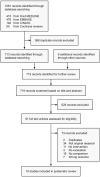Interventions to increase patient portal use in vulnerable populations: a systematic review
- PMID: 30958532
- PMCID: PMC6696508
- DOI: 10.1093/jamia/ocz023
Interventions to increase patient portal use in vulnerable populations: a systematic review
Abstract
Background: More than 100 studies document disparities in patient portal use among vulnerable populations. Developing and testing strategies to reduce disparities in use is essential to ensure portals benefit all populations.
Objective: To systematically review the impact of interventions designed to: (1) increase portal use or predictors of use in vulnerable patient populations, or (2) reduce disparities in use.
Materials and methods: A librarian searched Ovid MEDLINE, EMBASE, CINAHL, and Cochrane Reviews for studies published before September 1, 2018. Two reviewers independently selected English-language research articles that evaluated any interventions designed to impact an eligible outcome. One reviewer extracted data and categorized interventions, then another assessed accuracy. Two reviewers independently assessed risk of bias.
Results: Out of 18 included studies, 15 (83%) assessed an intervention's impact on portal use, 7 (39%) on predictors of use, and 1 (6%) on disparities in use. Most interventions studied focused on the individual (13 out of 26, 50%), as opposed to facilitating conditions, such as the tool, task, environment, or organization (SEIPS model). Twelve studies (67%) reported a statistically significant increase in portal use or predictors of use, or reduced disparities. Five studies (28%) had high or unclear risk of bias.
Conclusion: Individually focused interventions have the most evidence for increasing portal use in vulnerable populations. Interventions affecting other system elements (tool, task, environment, organization) have not been sufficiently studied to draw conclusions. Given the well-established evidence for disparities in use and the limited research on effective interventions, research should move beyond identifying disparities to systematically addressing them at multiple levels.
Keywords: consumer health information; healthcare disparities; patient access to records; patient portals; personal health records; vulnerable populations.
© The Author(s) 2019. Published by Oxford University Press on behalf of the American Medical Informatics Association. All rights reserved. For permissions, please email: journals.permissions@oup.com.
Figures
References
-
- Delbanco T, Walker J, Darer JD, et al. Open notes: doctors and patients signing on. Ann Intern Med 2010; 153 (2): 121–5. - PubMed
-
- American Hospital Association. Individuals’ Ability to Electronically Access Their Hospital Medical Records, Perform Key Tasks Is Growing. 2016. http://www.aha.org/research/reports/tw/16jul-tw-healthIT.pdf. Accessed February 8, 2017.
-
- HealthIT.gov. What is a patient portal? https://www.healthit.gov/providers-professionals/faqs/what-patient-portal. Accessed August 8, 2017.
Publication types
MeSH terms
Grants and funding
LinkOut - more resources
Full Text Sources
Medical



